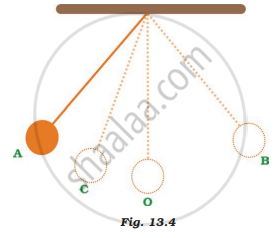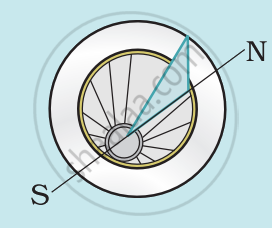Advertisements
Advertisements
प्रश्न
Fig. 13.4 shows an oscillating pendulum.

Time taken by the bob to move from A to C is t1 and from C to O is t2. The time period of this simple pendulum is
विकल्प
(t1 + t2)
2(t1 + t 2)
3(t1 + t 2)
4(t1 + t 2)
उत्तर
4(t1 + t 2)
Explanation:
Time taken by the bob to move from
A to O = t1 + t2
= tAO = tOA
Similarly, tOB = t1 + t2 = tBO
So, time period = tAO + tOB + tBO + tOA
= 4(t1 + t2)
APPEARS IN
संबंधित प्रश्न
The basic unit of time is second.
The basic unit of speed is ______.
Write true or false.
The S.I. unit of time is hour.
Answer the following in a word or two or in a sentence.
Name the unit which is common in both the MKS and CGS systems.
______ is used to measure the accurate time of the activity.
A ruler or scale used nowadays to measure length was invented by William Bedwell.
In earlier days, which instruments are used to measure time?
Who invented a ruler or scale?
Plot a distance-time graph of the tip of the second hand of a clock by selecting 4 points on the x-axis and y-axis respectively. The circumference of the circle traced by the second hand is 64 cm.
You can make your own sundial and use it to mark the time of the day at your place. First of all, find the latitude of your city with the help of an atlas. Cut out a triangular piece of cardboard such that its one angle is equal to the latitude of your place and the angle opposite to it is a right angle. Fix this piece, called gnomon, vertically along a diameter of a circular board a shown in Figure One way to fix the gnomon could be to make a groove along a diameter on the circular board.
Next, select an open space, which receives sunlight for most of the day. Mark a line on the ground along the North-South direction. Place the sundial in the sun as shown in Figure Mark the position of the tip of the shadow of the gnomon on the circular board as early in the day as possible, say 8:00 AM. Mark the position of the tip of the shadow every hour throughout the day. Draw lines to connect each point marked by you with the centre of the base of the gnomon as shown in Figure Extend the lines on the circular board up to its periphery. You can use this sundial to read the time of the day at your place. Remember that the gnomon should always be placed in the North-South direction as shown in Figure.

